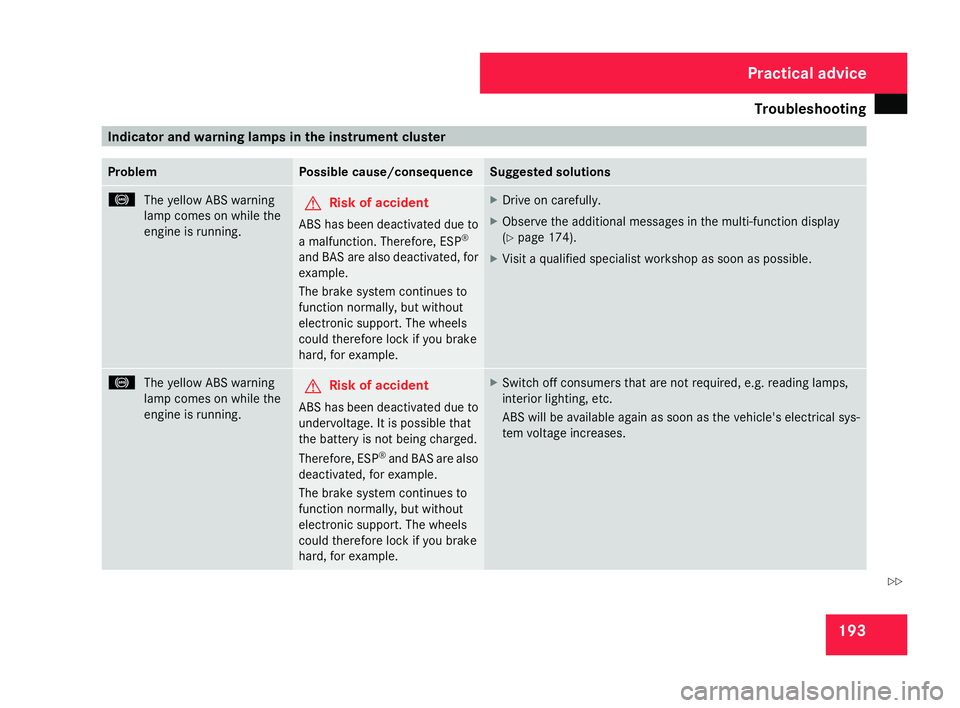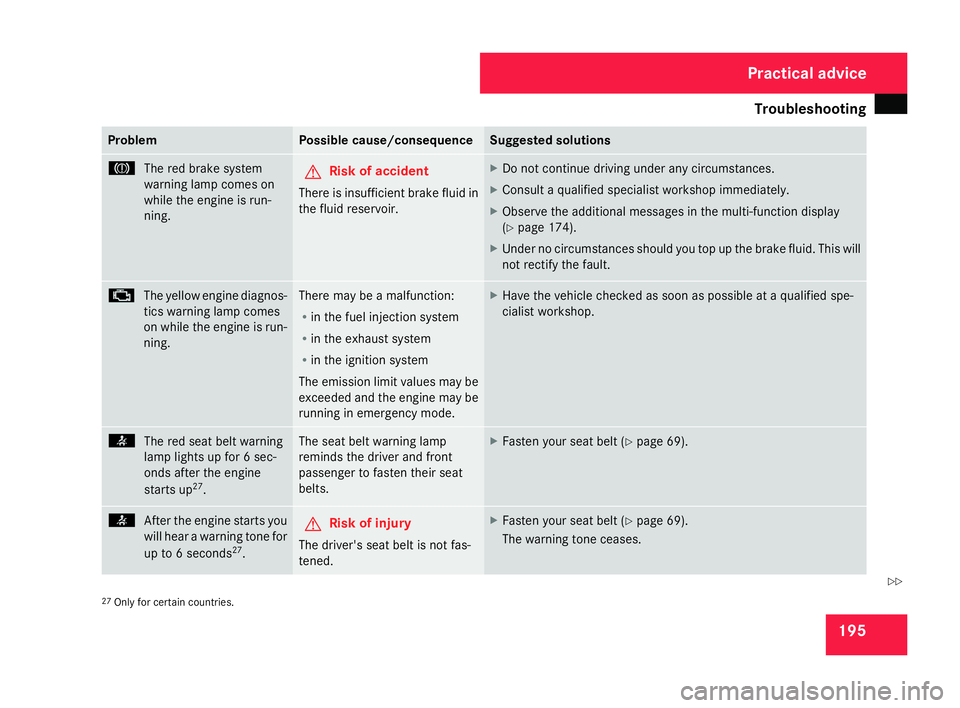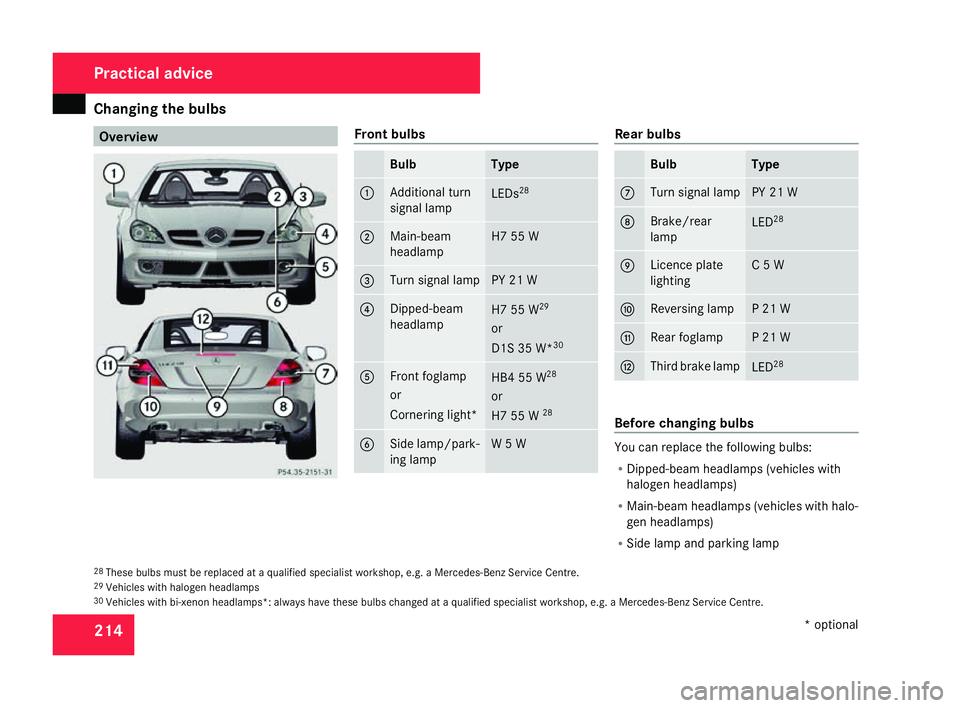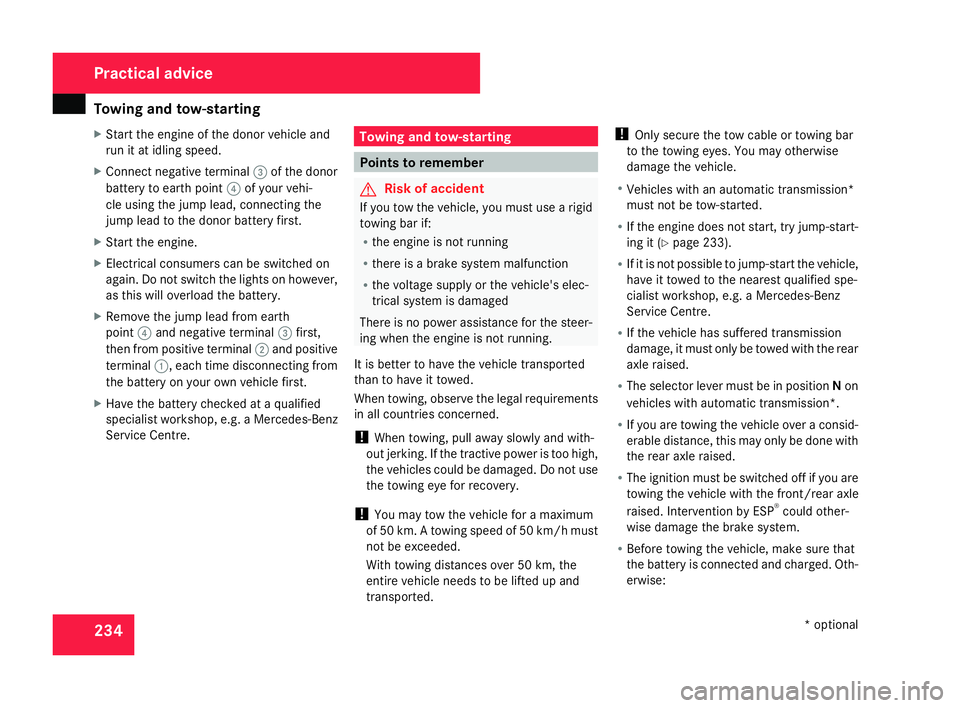2008 MERCEDES-BENZ SLK ROADSTER brake light
[x] Cancel search: brake lightPage 169 of 273

Car
e 166 Calling up the service due dat
e
Use the buttons on the multi-function steer-
ing wheel.
X Switch on the ignition.
X Press èorÿ to select the Basic
display menu(Y page 95).
X Press the jork button to select the
service information .
The 9 service symbol and the service
due date are displayed. Care
Notes on care
Regular and proper care maintains the value
of your vehicle.
i It is advisable to use Mercedes-Benz care
products.
Scratches, corrosive deposits, areas affected
by corrosion and damage caused by inade-
quate care cannot always be completely
repaired. In such cases, visit a qualified spe-
cialist workshop immediately, e.g. a
Mercedes-Benz Service Centre.
Repair damage caused by loose chippings
and remove the following substances imme-
diately, whilst avoiding rubbing too hard:
R Soak insect remains with insect remover
and rinse off afterwards .
R Soak bird droppings with water and rins e
off afterwards.
R Remove tree resin, oils, fuels and greases
by rubbing gently with a cloth soaked in
petroleum ether or lighter fluid .
R Use silicone remover to remove wax.
R Use tar remover to remove tar stains. H
Environmental not
e
Dispose of empty packaging, cleaning
cloths and polishing wads in an environ-
mentally responsible manner.
! Do not affix :
R stickers
R films
R magnetic plates or similar items
to painted surfaces, otherwise you could
damage the paintwork. Vehicle care
! Do not park the vehicle for a long perio d
of time directly after cleaning, especially if
the wheels have just been cleaned with a
wheel cleaner. Wheel cleaners could cause
rapid corrosion of the brake discs and
brake pads/linings. After cleaning, park
the vehicle when it is at normal operatin g
temperature.
Automatic car wash You can wash the vehicle in an automatic car
wash from the very start.Operatio
n
171_AKB; 3; 4, en-GB
vpfaff7,
2007-11-13T10:50:25+01:00 - Seite 166
Page 187 of 273

Display
messages 18
4 Display messages Possible cause/consequence Possible solution
. Brake/tail lamp
left
or
Brake/tail lamp
right The left-hand or right-hand brake lamp is
faulty. This message will only appear if all
LEDs have failed. X
Visit a qualified specialist workshop. . 3rd brake lamp The third brake lamp is faulty. This mes-
sage will only appear if all LEDs have
failed. X
Visit a qualified specialist workshop. . Main beam left
or
Main beam right The left-hand or right-hand main-beam
headlamp is faulty. X
Replace the bulb (Y page 213). . Licence plate
lamp, left
or
Licence plate
lamp, right The left-hand or right-hand licence plate
lamp is faulty. X
Replace the bulb (Y page 213). . Turn off lights You did not switch off the lights when
leaving the vehicle. X
Turn the light switch to MorU . . Turn off lights or
remove key The light switch is on
Uand you have
forgotten to remove the key. The side
lamps remain switched on . X
Remove the key from the ignition lock.
or
X Turn the light switch to M. Practical advice
171_AKB; 3; 4, en-GB
vpfaff7,
2007-11-13T10:50:25+01:00 - Seite 184
Page 196 of 273

Troubleshooting
19
3 Indicator and warning lamps in the instrument cluster
Problem Possible cause/consequence Suggested solutions
-
The yellow ABS warning
lamp comes on while the
engine is running. G
Risk of accident
ABS has been deactivated due to
a malfunction. Therefore, ESP ®
and BAS are also deactivated, for
example .
The brake system continues to
function normally, but without
electronic support. The wheels
could therefore lock if you brake
hard, for example. X
Drive on carefully.
X Observe the additional messages in the multi-function display
(Y page 174).
X Visit a qualified specialist workshop as soon as possible. -
The yellow ABS warning
lamp comes on while the
engine is running. G
Risk of accident
ABS has been deactivated due to
undervoltage. It is possible that
the battery is not being charged.
Therefore, ESP ®
and BAS are also
deactivated, for example .
The brake system continues to
function normally, but without
electronic support. The wheels
could therefore lock if you brake
hard, for example. X
Switch off consumers that are not required, e.g. reading lamps ,
interior lighting, etc .
ABS will be available again as soon as the vehicle's electrical sys-
tem voltage increases . Practical advice
171_AKB; 3; 4, en-GB
vpfaff7,
2007-11-13T10:50:25+01:00 - Seite 193 Z
Page 198 of 273

Troubleshooting
19
5 Problem Possible cause/consequence Suggested solutions
3
The red brake system
warning lamp comes on
while the engine is run-
ning. G
Risk of accident
There is insufficient brake fluid in
the fluid reservoir. X
Do not continue driving under any circumstances .
X Consult a qualified specialist workshop immediately.
X Observe the additional messages in the multi-function display
(Y page 174).
X Under no circumstances should you top up the brake fluid. This will
not rectify the fault. ±
The yellow engine diagnos-
tics warning lamp comes
on while the engine is run-
ning. There may be a malfunction:
R
in the fuel injection system
R in the exhaust system
R in the ignition system
The emission limit values may be
exceeded and the engine may be
running in emergency mode. X
Have the vehicle checked as soon as possible at a qualified spe -
cialist workshop. <
The red seat belt warning
lamp lights up for 6 sec-
onds after the engine
starts up 27
. The seat belt warning lamp
reminds the driver and front
passenger to fasten their seat
belts. X
Fasten your seat belt (Y page 69). <
After the engine starts yo u
will hear a warning tone for
up to 6 second s27
. G
Risk of injury
The driver's seat belt is not fas -
tened. X
Fasten your seat belt (Y page 69).
The warning tone ceases. 27
Only for certain countries. Practical advice
171_AKB; 3; 4, en-GB
vpfaff7,
2007-11-13T10:50:25+01:00 - Seite 195 Z
Page 200 of 273

Troubleshooting
19
7 Problem Possible cause/consequence Suggested solutions
A
The yellow reserve fuel
warning lamp comes on
while the engine is run-
ning. The fuel level has fallen below the
reserve range. X
Refuel at the nearest filling station .Warning tone
s Problem Possible cause/consequence Suggested solutions
The alarm of the anti-theft warn-
ing system* is triggered. You have opened the vehicle
using the emergency key element
without deactivating the anti-
theft alarm system* first. X
Switch off the alarm (Y page 53). You hear a warning tone. A message appears in the multi-
function display. X
See the explanations for the display message (Y page 174). You hear a warning tone. You are driving with the hand-
brake applied. X
Release the handbrake .You hear a warning tone. You have opened the driver's
door without switching off the
lights first. X
Turn the light switch to MorU . Practical advice
* optional
171_AKB; 3; 4, en-GB
vpfaff7,
2007-11-13T10:50:25+01:00 - Seite 197 Z
Page 217 of 273

Changing the bulbs
214 Overview Front bulbs
Bulb Typ
e 1 Additional turn
signal lamp
LEDs
28 2 Main-beam
headlamp H7 55
W 3 Turn signal lamp PY 21
W 4 Dipped-beam
headlamp
H7 55
W29
or
D1S 35 W* 30 5 Front foglamp
or
Cornering light*
HB4 55
W28
or
H7 55 W 28 6 Side lamp/park-
ing lamp W 5
W Rear bulb
s Bul
b Type
7 Turn signal lamp PY 21
W 8 Brake/rea
r
lamp LED
28 9 Licence plate
lighting C 5
W a Reversing lamp P 21
W b Rear foglamp P 21
W c Third brake lamp
LED
28 Before changing bulbs
You can replace the following bulbs:
R
Dipped-beam headlamps (vehicles with
halogen headlamps)
R Main-beam headlamps (vehicles with halo-
gen headlamps)
R Side lamp and parking lamp
28 These bulbs must be replaced at a qualified specialist workshop, e.g. a Mercedes-Benz Service Centre .
29 Vehicles with halogen headlamps
30 Vehicles with bi-xenon headlamps*: always have these bulbs changed at a qualified specialist workshop, e.g. a Mercedes-Benz Service Centre. Practical advic
e
* optional
171_AKB; 3; 4, en-GB
vpfaff7,
2007-11-13T10:50:25+01:00 - Seite 214
Page 237 of 273

Towing and tow-startin
g234
X
Start the engine of the donor vehicle and
run it at idling speed .
X Connect negative terminal 3of the donor
battery to earth point 4of your vehi-
cle using the jump lead, connecting the
jump lead to the donor battery first.
X Start the engine.
X Electrical consumers can be switched on
again. Do not switch the lights on however ,
as this will overload the battery.
X Remove the jump lead from eart h
point 4and negative terminal 3first,
then from positive terminal 2and positiv e
terminal 1, each time disconnecting from
the battery on your own vehicle first .
X Have the battery checked at a qualified
specialist workshop, e.g. a Mercedes-Benz
Service Centre. Towing and tow-starting
Points to remember
G
Risk of accident
If you tow the vehicle, you must use a rigid
towing bar if:
R the engine is not running
R there is a brake system malfunctio n
R the voltage supply or the vehicle's elec-
trical system is damage d
There is no power assistance for the steer-
ing when the engine is not running.
It is better to have the vehicle transported
than to have it towed.
When towing, observe the legal requirement s
in all countries concerned.
! When towing, pull away slowly and with-
out jerking. If the tractive power is too high,
the vehicles could be damaged. Do not use
the towing eye for recovery.
! You may tow the vehicle for a maximum
of 50 km. A towing speed of 50 km/h must
not be exceeded.
With towing distances over 50 km, the
entire vehicle needs to be lifted up and
transported. !
Only secure the tow cable or towing bar
to the towing eyes. You may otherwise
damage the vehicle.
R Vehicles with an automatic transmission*
must not be tow-started.
R If the engine does not start, try jump-start-
ing it (Y page 233).
R If it is not possible to jump-start the vehicle ,
have it towed to the nearest qualified spe-
cialist workshop, e.g. a Mercedes-Ben z
Service Centre.
R If the vehicle has suffered transmission
damage, it must only be towed with the rear
axle raised.
R The selector lever must be in position Non
vehicles with automatic transmission*.
R If you are towing the vehicle over a consid-
erable distance, this may only be done with
the rear axle raised.
R The ignition must be switched off if you are
towing the vehicle with the front/rear axle
raised. Intervention by ESP ®
could other-
wise damage the brake system.
R Before towing the vehicle, make sure that
the battery is connected and charged. Oth-
erwise : Practical advice
* optional
171_AKB; 3; 4, en-GB
vpfaff7,
2007-11-13T10:50:25+01:00 - Seite 234